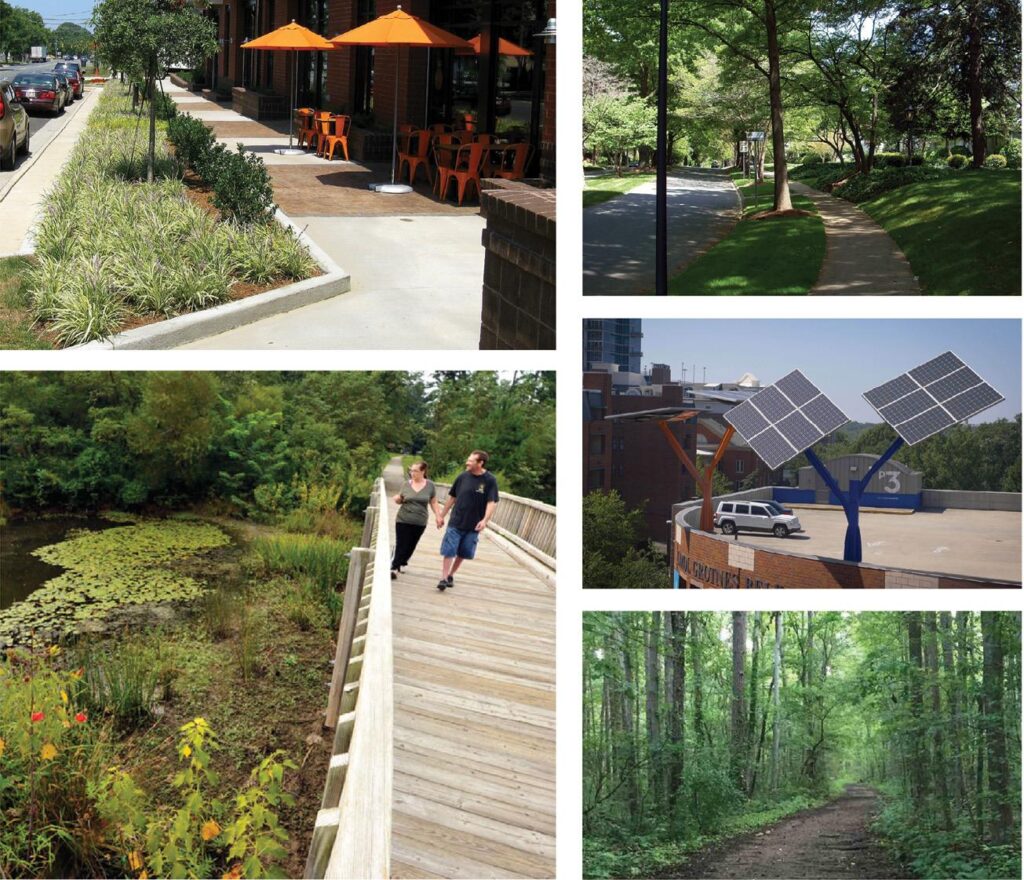Home / 03. Policy Framework / Goal 7: Integrated Natural and Built Environments
Plan Policy
Table of contents
Goal 7: Integrated Natural and Built Environments

Goal 7: Integrated Natural and Built Environments

Charlotte will protect and enhance its surface water quality, tree canopy, and natural areas with a variety of trees, plantings, green infrastructure, green building practices, and open space at different scales throughout the entire community as a component of sustainable city infrastructure that addresses the threat of climate change.

Objectives
- Increase the number of small parks and plazas within or near neighborhoods and neighborhood centers that contain community amenities such as recreation facilities, tree canopy, retrofit stormwater facilities, and water quality/natural resource education.
- Increase the acreage of protected (including public and private) natural lands (such as forests and natural areas) within the City.
- Improve surface water quality such that all City streams meet surface water quality standards.
- Increase the acreage of amenitized open space and forested or tree-shaded open space within private developments that are open to the public.
- Reduce the number of flood prone areas through mitigation efforts.
- Strive to source 100% of energy use in municipal buildings and fleet from zero carbon sources by 2030.
- Reduce per capita carbon emissions in the City.
- Slow canopy loss on privately owned residential properties.
- Improve quality of tree canopy (age, species, etc.) to ensure it lasts for future generations.
- Increase the number of developments utilizing clustered residential and low-impact development, and green building practices or receiving green building certifications.
- Continue to expand the use of green stormwater infrastructure to improve water quality and reduce flooding, including infill and redeveloping areas.
Big Policy Ideas
- Implement the Strategic Energy Action Plan by implementing Resilient Innovation District (RID) programs throughout the City that are responsive to different Place Types and contexts and promote net zero development and carbon neutrality
Policies
- Continue to implement and encourage green stormwater infrastructure (such as bioswales, rain gardens, and green roofs).
- Require tree preservation on all sites while allowing innovative and flexible mitigation measures for sites with competing city priorities.
- Update development regulations to better mitigate impacts from development and infill development such as stormwater runoff and tree removal.
- Consider adopting new development regulations that encourage energy efficiency improvements in existing residential and commercial buildings with emphasis on high energy users.
- Continue to require development of publicly accessible shared-use path sections that connect the City’s network through private developments and change private development standards to ensure that path sections constructed on private lands meet public standards. (cross-reference: Goal 4)
- Review development regulations for opportunities to remove barriers, and/or create requirements or incentives for sustainable development practices, including regulations relating to implementation of solar power through community solar arrays, energy efficiency in buildings, electric vehicle charging stations, and battery energy storage in residential and non-residential areas.
- Prioritize preservation of large, healthy, mature trees and existing contiguous healthy forests.
- Expand and enhance solutions to control or eliminate invasive plant species on public lands and in tree preservation areas during development.
- Protect trees of a certain health and size on public and private property through changes in regulatory and administrative practices, incentives and education.
- Ensure sufficient resources for City staff to enforce policies and codes, monitor progress, educate and review environmental performance against targets and objectives on a regular basis. Ensure all projects include funding to assess environmental impacts and ensure compliance with applicable environmental legislation.
- Fully fund a proactive care program and strategic tree planting program for all public trees to ensure safety, longevity and maximum public benefit.
- Increase sustainable and resilient building standards applicable to existing and new City owned buildings through a revised Sustainable Facilities policy – for example, require LEED certification for new construction, solar energy generation where feasible, energy benchmarking, temperature set points, and net zero energy consumption.
- Continue to preserve and protect tree canopy on City-owned properties and consider a tree planting program on City-owned properties available for public use, such as the Urban Arboretum Trail and Program.
- Purchase high priority natural lands that serve important City interests such as stormwater management, recreation, and water quality.
- Evaluate all relevant life cycle costs of using green stormwater infrastructure or more traditional engineered stormwater systems when making public infrastructure investment decisions.
- Increase investment in green space and tree canopy initiatives to support housing and neighborhood policies and ensure residents are connected to nature and environmental justice issues are avoided. (cross-reference: Goal 1, Goal 2, Goal 3)
- Develop community partnerships, funding, and regulatory concepts to facilitate the removal of invasive species on private property and increase the quality of our tree canopy.
- Invest in the assessment and monitoring of tree data from year to year.
- Establish new partnerships and expand existing partnerships with Mecklenburg County and other stakeholders that may include other non-governmental organizations (NGOs), community organizations, and nonprofits to secure private funding and support to develop new and existing parks, tree canopy and shared-use paths, and the protection of open spaces as neighborhoods grow.
- Continue working with Mecklenburg County Land Use and Environmental Services Agency within shared watersheds to set resiliency policies, establish implementation programs, and implement consistent regional standards to manage change within watersheds. Use the Charlotte-Mecklenburg All Hazards Plan and future County stormwater residual flood risk goals to guide these efforts.
- Continue to test, pilot, and document green storm-water infrastructure best management practices.
- Develop a dashboard to track progress towards the City’s climate action goals.
- Evaluate the quality of and accessibility to parks, particularly in underserved communities, and partner with the County to set higher standards as identified. (cross-reference: Goal 6)
- Encourage green building techniques and practices in all types of renovations and new developments, implement the Charlotte Sustainable Facilities Policy, and continually review effectiveness of policies and regulations that support sustainable development.
- When there are perceived or real conflicts between trees and other city priorities, economic development projects, and infrastructure improvement projects, where feasible the City will support creative and innovative solutions that protect the tree canopy and complement other goals.
- Continue diversifying recreation opportunities to provide inclusive environments for all ages and abilities.
- Explore programs to protect natural and less developed lands that serve important recreational and natural drainage purposes through means such as conservation easements in partnership with Mecklenburg County, land trust partners, and landowners.
- Develop a benchmarking policy for larger commercial buildings to compare energy and water usage over time and encourage conservation measures.
- Continue to transition the City to a circular economy by expanding programs that maximize product reuse and recycling and minimize waste, such as City-wide composting.
- Advance the City’s sustainability goal to reduce carbon emissions through expanded electric vehicle infrastructure, better access to alternative modes of transit, increased energy efficiency in buildings, and increased use of solar energy at City-owned buildings.
- Increase the number of developments utilizing conservation design and low-impact development.Recommended Projects and programs
- Develop climate change and disaster resilience plans for each neighborhood and use the future Mecklenburg County Stormwater residual flood risk goal data and Charlotte-Mecklenburg All Hazards Plan to guide mitigation actions.
- Monitor and develop programs to mitigate the effects of urban heat island effect in historically red-lined communities.
- Establish programs to educate the public on how to reduce individual environmental impact through sustainable practices relating to water usage, composting, fertilizers, and energy usage.
- Replace the City’s fleet with electric or hybrid vehicles.
- Improve the City’s composting and recycling programs.
- Consider a program to help pay for energy efficiency improvements in low-income neighborhoods.
- Work with the County on the development of an app that provides an interactive map of all public parks, open spaces, and trails.
- Consider requiring bathymetric surveys as part of new developments to measure potential impacts of new developments on lakes and ponds located downstream of the development.
- Explore tools to ensure streams and steep slopes have sufficient buffers of high-quality trees and associated vegetation to control erosion, nutrient loads and other pollution.
- Conduct a study of existing wildlife habitat/migration patterns to identify gaps in the ecological system. Map these locations and compare with sites identified for new park and recreation facilities, shared-use paths, enhanced tree canopy, riparian corridors, and areas targeted for green stormwater infrastructure facilities to identify overlapping open space priorities.
- Implement a signage program throughout the City to provide clarity for shared-use path and park connections.
- Modify development regulations for zoning districts associated with neighborhoods to provide publicly accessible open spaces as part of private developments.
- Using the Tree Conservation Fund and potentially new funding sources, develop a program for land acquisition or conservation easements to support protection of prime conservation lands.
- Explore development of a climate action plan to determine specific targets and metrics for carbon footprint reduction city-wide.
- Evaluate opportunities to use trees and other vegetation on existing vacant parcels to provide ecosystem services (e.g. erosion control, stormwater and water quality services) to address surface water quality in the City.
- Promote conservation easements to protect undisturbed forest patches and/or reforested areas, especially on vacant or industrial parcels.
- Promote a healthy and diverse tree canopy, including:•Uneven-aged, predominantly overstory broadleaf and coniferous trees with a native/ornamental mixed species understory; •Street trees of diverse species and a sustainable age distribution; and •Ornamental trees used for visual interest and aesthetics, especially where utilities, signs, lights, and other constraints exist.
- Support tree maintenance on private land in underserved and/or vulnerable neighborhoods and review recommendations provided in the Urban Forest Master Plan.
- Establish minimum indoor air quality standards for certain classes of buildings (e.g. CMS schools, City buildings, etc.).
- Implement Resilient Innovation Districts (RIDs) in communities throughout the City to encourage investment and experimentation into the best ways to establish energy independence. Existing Smart District and TOD Districts should receive priority consideration for implementation of low carbon programs and policies as they are prime locations for piloting these new RID programs.
- Develop a comprehensive education and stewardship initiative to teach and equip residents to sustain our natural systems and tree canopy.
- Increase awareness and quantity of the urban tree canopy with neighborhood serving public space through the Urban Arboretum Program.

Image source: https://www.greenwichapts.com/
Cincinnati is taking a direct approach toward integrating the natural and built environment by increasing its urban tree canopy cover. This method will reduce the cost of cooling for residents, reduce the concentrations of air pollutants, and help mitigate flood, stormwater, and landslide risks. The City’s goal is to increase the citywide tree canopy coverage to at least 40% and ensure that canopy cover is at least 30% in all residential neighborhoods.
